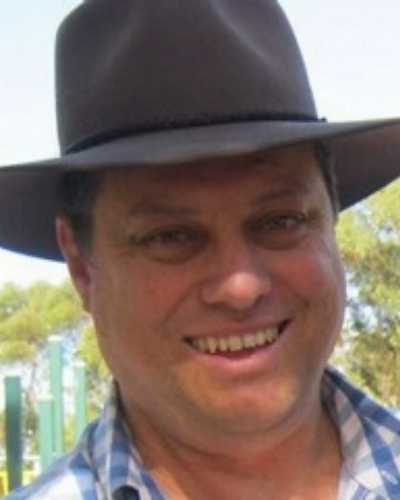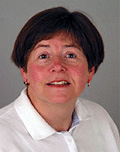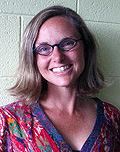Context
Introduction
In Australia, the Bachelor of Nursing (BN) for registration is a three-year undergraduate degree. On successful completion, graduates are eligible for registration. The School of Nursing and Midwifery at the University of Tasmania, Australia, is the only bachelor of nursing provider in the State of Tasmania. This arrangement is unique among Australian states, which all have multiple providers. In Tasmania's situation, community based nursing students are dispersed for their clinical practica across metropolitan, urban, rural and remote clinical nursing practice2. In addition, students are offered opportunities to experience large metropolitan community nursing facilities through collaborative arrangements with other state capitals' healthcare providers (in Sydney and Melbourne). The locations and range of practice is diverse, and students may be located in up to 91 facilities that cover over 20 differing areas of community health, including adolescent health, child and family health, cardiac rehabilitation, community aged care, women's and men's health, specialist clinics (eg wound care, asthma or diabetes) and rural community nursing.
Issue
Providing a curriculum that meets the requirements of the course registering authority as well as the individual clinical learning requirements is challenging. Authentic learning in the context of diverse and dispersed community based nursing practice, is difficult to ensure. However the intent to improve the health status of the population served through community practice nursing interventions, guided by primary health care principles, is common to all clinical placements. A curriculum designed to standardise community health practice experience and theory may not address students' learning needs in any of the practice areas. These challenges have been addressed in an experiential learning approach that focuses on the needs of the learner, and this article provides an exemplar of its application.
The fundamental principles that hold the diverse curriculum together are: (i) the experiential focus; and (ii) the partnership developed between the university and the facility that supports both students and facilitator/preceptors. These two elements will be discussed in this article.
The community based nursing subject within the BN has a primary healthcare framework as philosophy and builds on key primary healthcare concepts in order to advance the health of people in community settings. This subject provides an opportunity for students to develop an understanding of community based health issues and the role of nurses in the community.
The students commence the semester with a two-day intensive workshop to introduce them to the theory underpinning their community nursing practice. They then undertake self-directed preparation for their clinical practice which includes making phone contact with their allocated facility and their preceptor. The preceptor takes this opportunity to request the student undertake any specific preparation necessary for their specialty area of practice (eg family planning services), and interviews the student regarding their perceptions and attitudes to the area of nursing. Students then meet with their tutorial group for a 3 hour workshop in week two, prior to attending their first day of clinical practice, which is usually on the next day. Over the subsequent 6 weeks, students attend a 3 hour workshop and 24 hours of clinical practice each week. In total over the semester the students attend 144 hours of clinical practice and 24 hours of workshops.
Because the community based nursing practice is taught from various locations, students are offered differing teaching patterns to suit their learning needs and the region's resources. In 2007 all students were offered a combination of:
- intensive workshops (mentioned above)
- clinical preceptor support at all times on practicum
- 24 hour web-based access to all teaching material
- asynchronous email support and discussion groups
- phone contact with teaching academics while attending clinical practice.
Regional support may also require offering the following strategies:
- video conferences from the university campus to the clinical region
- clinical visits to the region by the academic to support the preceptor and the student.
Experiential learning
Theories of adult learning support active learning as a means of enhancing learning outcomes. Experiential learning is where a learner tries out theory in practice and, as a result, forms new knowledge that captures their social reality3. Mapping the pathways of learning4 highlights some experiences of learning as relatively meaningless, while other experiential learning opportunities provide enhanced learning outcomes. Figure 1 maps the pathways of learning described in this article. This map provides two theoretical student pathways for comparison. The first pathway illustrates community practicum experienced separately from an integrated curriculum. The second pathway illustrates where the teaching strategies discussed in this exemplar influence student learning outcomes. The different outcome is achieved through the learner's use of reflection and self-evaluation. This process is supported in our program by the workshops, reflective journal and expert clinical preceptors.
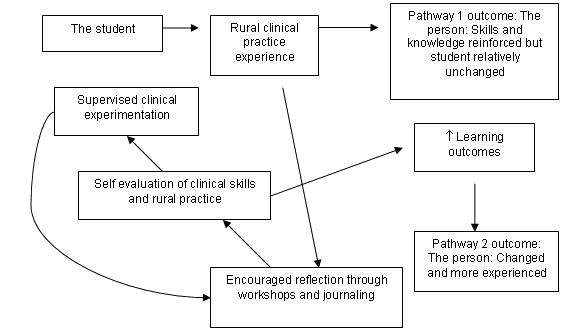
Figure 1: Experiential Learning map (adapted with permission from 3).
This experiential learning map is supported in this exemplar qualitatively with our emic perspective as teachers of this curriculum, student evaluation results and preceptor feedback. Empirical testing through quasi-experiments or ex-post factor research could feasibly test such curriculum mapping. The major difficulty in such research is the inherent difficulty in controlling for confounding variables.
Experiential learning is highly individual, allowing students to be involved in their own learning activities. It is influenced by prior learning and allows for construction of one's own knowledge thus providing the potential of deep learning outcomes. Reflection on and re-evaluation of the experience assists the student to find meaning in the clinical experiences and events, and to integrate their newfound knowledge. In experiential learning, students learn from their own experiences as well as third-person experience through stories in authentic learning environments5. Undertaking this authentic learning process in the workshop provides a safe and guided environment for story-telling, reflection and evaluation.
Teaching strategies for enhancing experiential learning outcomes
Regular experiential-based learning workshops for students while on practicum, supplemented with teaching of essential community based nursing theory and skills are necessary to maximise the learning outcomes from the students' own, and also other students' clinical experiences. Facilitating experiential learning requires unique skills of the teacher who draws out the necessary individual meanings for collective learning. Two such teaching strategies from our experiential course are described: regular reflective workshops, and journaling and journal clubs.
Reflective workshops: Experiential learning has been utilised successfully to stimulate deeper learning and to consolidate theory in context of nursing practice6. The regular workshops encourage reflection on and group discussion of previous clinical experiential learning. Initial workshop discussions focus on a reflective account of a clinical episode of one of the students. The teacher then draws out salient points in light of relevant theory and previous discussions. All students are free to contribute to the discussion and often relate the way the episode is mirrored by or contrasts with one of their own clinical episodes. During this discussion, the teacher facilitates rather then directs the discussion. The workshop leader pulls ideas together and encourages maximum participation from the other students. Stein-Parbury's6 suggestions for facilitators of experiential learning through role play have been adapted for use in the clinical practicum context, and the following points are made.
Because meaning derived from an experience is personalised, there is no correct way to respond to a student's clinical episode of practice. This may be uncomfortable for a facilitator accustomed to instructive teaching and who may not have personally experienced what was raised in the clinical episode. The facilitator needs to let go of procedural approaches to allow learners to derive personally relevant meaning from the experiences; and to function as a guide on a journey, rather than an expert who demonstrates how it 'should' be done.
Sometimes shared episodes of practice are difficult to construct meaning from and even ineffective, producing a 'so what?' experience. Others in the group may not have much to say in response to such an episode. When a discussion seems to be 'going nowhere', it may be useful to ask a general question such as, 'Why do you think this occurred?' or 'What else is going on here?' and 'What important events from the past may be impacting on this episode of practice?' At this point another student may offer a similar episode that they experienced and the telling of a similar experience may raise surprising insights. At other times, there is 'nothing developing' and the episode should be abandoned, while continuing with the reflective experiential learning exercise from another episode.
Students should keep a reflective journal and read over the entries before attending the workshop. When participants seem hesitant to engage in reflection and discussion, make sure that workshop preparation has been accomplished. Do not assume that hesitancy is a result of lack of interest or motivation. Always assume participants' goodwill, this helps to establish trust.
At the start of the semester, it may be beneficial to begin formal experience-based classes with a short and focused 'warm-up' activity, which helps prepare participants to learn in an active, involved manner. Some suggestions for warm-up activities include:
- Brainstorm by generating as many ideas as possible about a given topic (eg the implications for health outcomes or access of a recent government policy).
- Tell a personal experience. Share a personal clinical episode or personal anecdote about clinical experience (but do not allow students to come to rely on the facilitator's experiences for their own reflective learning).
Journal clubs: The second method offered to encourage reflective learning from experience is the establishment of a journal club7. At this (undergraduate) level the intent is for students to identify an article that supports or conflicts with community based practice interventions they are experiencing, rather than critical analysis of a research article8.
In groups of five or six students, each presents their selected article and facilitates a group discussion of approximately 20 min duration. The article is distributed a week before the scheduled journal club (in a tutorial or electronically), and is required to be read prior to the scheduled meeting. Discussion is to be facilitated by the presenter and guided by the following:
- the rationale for choosing the article is based on the presenter's clinical experience
- a summary of the article is given: what the article intends to investigate, the methodology and outcomes
- the application of the article to practice, including recommended changes to practice, and 'threats' to and 'opportunities' from these recommendations.
The lecturer's role is that of participant observer, and in this capacity the format of a journal club can successfully support deep or meaningful learning from experience9.
The supportive partnership
Maximising positive student exposure to rural and remote facilities is a key to creating long-term benefits for rural and remote communities in terms of addressing their current healthcare professional shortages. A positive undergraduate experience positively influences students' perceptions about future intentions towards rural practice and interest in rural health issues10. This is especially important for students studying through a metropolitan university with urban practicum placements.
However embedding compulsory rural health experiences in metropolitan undergraduate courses is costly and difficult to sustain11 and in this aspect regional campuses have an advantage. However the quality of the placement is also a major concern, and regional students may also experience the difficulties of rural practice placements, often far from their home campus and established living arrangements.
Supporting students experiencing practicum
A quality rural clinical experience includes not only the clinical practice that the student engages in but also their living arrangements and learning support while in the rural region, as well as support and effective teaching strategies when back on the home campus. Students need transport to the placement and often require transport assistance whilst on placement. Accommodation needs are a high priority. Family and partner issues need consideration. Financial assistance and incentives are also important12. Student support prior to attending practicum is important to ensure that undue stress is alleviated. The opportunity to make first contact via the phone with a preceptor prior to meeting in the clinical facility helps establish the preceptor-student relationship. For this to occur, partnerships between the university and the clinical facility need to be established.
Learning support for students experiencing practicum
Support of the student in the clinical environment is essential in establishing a positive rural experience. The preceptor is a current clinician in the placement thus ensuring all students have easy access to an expert who is not only familiar with all the characteristics of the placement but also aware of the learning, emotional and social needs of the student. Clinical experience has been identified as one of the most anxiety producing components of an undergraduate nursing program13. Students also identify that they perceive a theory-practice gap when curricula are taught devoid of expert clinical input. Preceptors are an ideal means of supporting students in rural practice by a respected local clinical expert who reduces the anxiety for the student and the perceived theory-practice gap13.
While on practicum the School of Nursing and Midwifery students participate, under supervision and in collaboration with their preceptor, in community practice nursing interventions (CPNI). This framework is an adaptation of the Public Health Nursing Interventions Model14 and Competency Standards for the Community Health Nurse15. The CPNI framework provides a clear guide to the scope of practice expected of the student. The CPNI highlights and validates the community based nurse's role in the delivery of care within the context of their client's community. The adoption of the two resources listed above, serves to help nursing students understand the application of CPNI as broader than providing home care and conducting delegated medical treatment, observations and teaching interventions at the individual level. Thus the CPNI encompass the broad and diverse nature of community based nursing settings and roles students experience while on practicum.
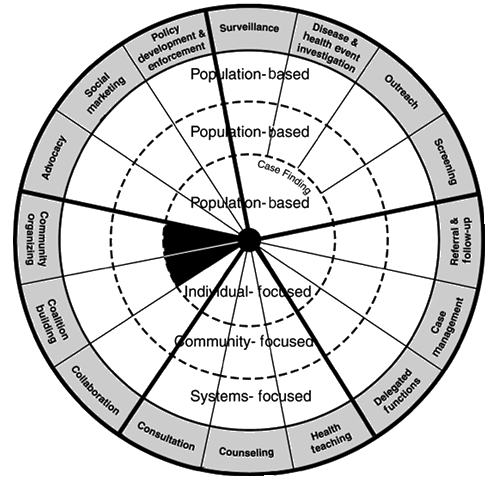
Figure 2: Community Practice Nursing Interventions Wheel (reproduced with permission from 14).
A personal reflection on supporting students and preceptors
The following account of supporting the preceptors and students in practice is from one of the most experienced member of the teaching team. An essential element of the authenticity of the teaching arises from the seamless practitioner-educator role of this teacher. We have included the use of expert clinicians from within the regional community placements wherever possible. The local expert clinicians are important in this program in an essential teaching role in the on campus workshops and also as preceptors for the students.
From my communications with preceptors in the community I soon became aware of their expectations of and desire for liaison with the academic. Regular contact from myself by telephone and in person satisfied this expectation. In student teacher evaluations regular comments highlight that students perceive these activities as important to them. For example, one student commented, 'Yes, it was good that we were visited in our placement to discuss how we were going', and another student believed, 'Visiting students is a really good way to see how we're going and for us to ask questions', with another student stating '...phoning and calling to see students by the academic' was a highlight of my practice. My strategies for providing this contact are structured and uniform. I ring all agencies at the end of students' first week in practice to see how things were going with the student, and if there are warning bells from the preceptor, I visit very quickly. I do this to offer support to student and preceptor. Also at this time I make arrangements for a visit early in the student's experience. I have a standard protocol for phoning and/or visiting during the students' time at the agency. I am prompt in informing agencies of changes in student placements. The literature identifies that for student preceptors and mentors in the community to be most effective with students, efficient communication links with the educational providers are required16. Whilst the student is on their practicum, these actions are an indication for the student of the value the academic places on the practicum experience. A recent student commented, 'I liked the way our tutor made a point of visiting everyone on their 'worksite' to keep in touch with students, and to address any problems that may arise. I felt this was an important sign of respect for students and not letting them feel stranded'.
Because I keep in regular contact I have good working relationships with preceptors. I believe that if preceptors are happy with their communications and relationship with the university, they are more likely to provide good quality experiences for students. The findings of Janes'17 support the need for schools of nursing to maintain good communication with preceptors to ensure they are well informed and supported about their role in providing good student experiences. Sharples and Kellyreport that for the student to get the most out of their community experience, the nurse precepting them needs to be well supported18. During visits I answer any questions either student or preceptor may have on the placement or assessment items. Students often have questions about their CPNIs and preceptors may have questions about assessing students in practice against competencies. I encourage students to share their journal club research articles with their preceptors so they are making a positive contribution to the practice agency initiating conversations that lead to reflection and enhances learning outcomes. Community preceptors comment regularly they value interaction with students as it keeps them up to date on current research in their area and makes them aware of why they do things the way they do, as they often have to explain this to students. Regular contact for liaison between university and practice agencies is seen as very important to students and staff and has also been seen to decrease the theory practice gap19. In my experience of supporting students in practice I recall many RNs commenting that they do not hesitate to call me if they have concerns.
When not working at the university (I am a part time academic), I work in the community as a Family and Child Health Nurse. This allows me to refer to experiences from my current clinical practice to illustrate issues and to gain credibility. As well, approximately every year I also go out with a community nurse (in a different area of practice from my own) for a day so I can see what health issues clients are experiencing and what CPNIs are engaged. This increases my credibility with students and also my ability to knowledgably discuss the CPNIs.
Lessons learned
Maximising student exposure to rural and remote facilities, enhancing experiential learning opportunities and engagement in teaching material is the key to enhancing learning outcomes that create long term benefits for rural and remote communities. Supported experiential learning is the ideal medium to increase student learning outcomes, confidence in their clinical abilities, autonomy, responsibility and decision making ability. This engagement of students in the learning process whilst exposing students to a broader scope of clinical practice ensures development of the independent practitioner skills necessary for rural & remote practice appropriate for the beginning practitioner.
Although this mapping and the effectiveness of these strategies are only supported qualitatively, it is envisioned that as a result of these curriculum developments, the graduates will be more readily accepting of and willing to choose rural & remote clinical facilities and communities as legitimate places for their professional careers. Once active within the communities, the graduates will be better placed to independently access the information needed for continued professional development and maintain professional competence within the rural and remote facilities.
References
1. Yeats WB. The Quotations Page. (Online) no date. Available: http://www.quotationspage.com/quote/36080.html (Accessed 12 June 2008).
2. Australian Institute of Health and Welfare. Rural, regional and remote health: a guide to remoteness classifications. AIHW cat. no. PHE 53. Canberra: AIHW, 2004
3. Javis P. Learning in later life: An introduction for educators and carers. London: Kogan Page, 2001.
4. Rae J, Breen H. What makes a telehelath user? Mid Western Area Health Service Nursing monograph. Bathurst: Charles Sturt University, 2003.
5. Koenders A. An authentic online learning environment in university introductory biology. In: A Herrington, J Herrington (Eds). Authentic learning environments in higher education. Hershey, PA: Information Sciences, 2006.
6. Stein-Parbury J. Patient and person. Interpersonal skills in nursing, 3rd edn. Sydney, NSW: Elsevier, 2005.
7. Kleinpell RM. Rediscovering the value of the journal club. American Journal of Critical Care 2002. 11(5): 412-413.
8. Ferguson L M, Day R A. Challenges for new nurses in evidence-based practice. Journal of Nursing Management 2007; 15: 107-113.
9. Biggs J. Teaching for quality learning at university: what the student does. Buckingham, UK: Open University Press, 2003.
10. Gum LF. Studying nursing in a rural setting: Are students adequately supported and prepared for rural practice? A pilot study. Rural and Remote Health 7: 628. (Online) 2007. Available: www.rrh.org.au (Accessed 11 June 2008).
11. Crichley J, DeWitt D E, Khan M A, Liaw S T. A required rural health model increases students' interest in rural health careers. Rural and Remote Health 7: 688. (Online) 2007. Available: www.rrh.org.au (Accessed 11 June 2008).
12. Jones GI, DeWitt DE, Cross M Medical students' perceptions of barriers to training at a rural clinical school. Rural and Remote Health 7: 685. (Online) 2007. Available: www.rrh.org.au (Accessed 11 June 2008).
13. Sharif F, Masoumi S. A qualitative study of nursing student experiences of clinical practice. BMC Nursing 2005; 4(6): 1-7.
14. Keller-Olson L, Strohschein S, Lia-Hoagberg B, Schaffer, M. Population-based public health interventions: practice-based and evidence-supported. Part I. Public Health Nursing 2004: 21(5): 453-468.
15. Department of Health and the Community Nurses Special Interest Group. Competency standards for the community health nurse, 2nd edn. Perth, WA: Australian Nursing Federation, 2001.
16. Hall A. Mentorship in the community. Journal of Community Nursing 2006; 20(7): 10-12.
17. Janes BA. Preparing and supporting preceptors of senior undergraduate nursing students' (PhD thesis).
18. Sharples K, Kelly D. Supporting mentors in practice. Nursing Standard 2007; 21(39): 44-48.
19. Williamson GR, Webb C. Supporting students in practice. Journal of Clinical Nursing 2001; 10(2): 284-292.
